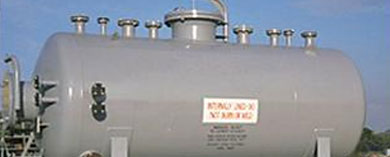
- (03) 5909 8218
- enquiry@fusionweld.com.au
What are Static Pressure Vessels and Their Applications?
August 12, 2014

Static pressure containers are designed to store linear loads, spanning mass and volume differentials that far exceed the ambient pressure characteristics of the material being stored. The reasoning behind this type of fabrication is rooted in safety factors, with a secondary focus on protecting pure contents from contamination.
Pressurizing hazardous materials to a closely monitored static value is a well known method of harnessing the laws of physics to diminish the dangerous and unpredictable characteristics of a chemical fuel, especially if that fuel exists normally in another state. Imagine a simple bottle of soda pop or the closed radiator system threading through the engine compartment of an automobile. Remove the top of the bottle or the radiator cap and there's a dynamic reaction of gases, and, in the case of the car radiator, a sudden change of pressure that alters the boiling point of the coolant. These fundamental laws of physics are harnessed in pressure vessel designs to reduce the potential danger of a highly flammable gas or liquid. The static pressure vessel holds the gas at a certified value, condensing the gas into its fluid state, greatly diminishing its threat.
Therefore, static pressure changes the properties of stored contents, offsetting an evaporative characteristic by condensing a substance, reducing the space the gas or liquid would fill at the standard atmospheric pressure we exist under. Of course, unlike high pressure applications, static pressure containment depends on striking a balance, on removing undesirable transient changes of pressure, swapping those changes for an absolutely flat line. Monitoring gauges and precision valves outfitted with high-end instrumentation play their parts in maintaining this linear characteristic, but it's the design and fabrication of the vessel that's the primary factor in supplying the tensile strength to keep the container's shape and structure during events that may introduce transient change. The material is fabricated and rolled, welded and tested to ensure it doesn't flex during temperature changes or sudden pressure variations.
Applications of a sound static pressure tank employ superlative design and fabrication technology to keep combustible fuel stored at a precise volume, condensed under the laws of pressure theory to keep the chemical, a petroleum product or ammonia byproduct, in a subdued liquid state. Pressure differentials keep grain and farm seed pressurized to keep the agricultural matter from spoiling, fostering a system of agronomy storage that matches any chemical refinery. The same pressurization process spurns the presence of contaminants, a particularly important consideration when storing foodstuff. Note, other factors in farming silos can complicate static pressure vectors, factors that include the drying of the grain. Lower static pressures are used in these circumstances, with extraction fans removing any pressure altering factors.
The twofold benefits of static pressure storage bring safe storage in smaller spaces and contaminant free containment to industry and agriculture. These commercial ventures depend on high-quality constructs, vessels made with predictable and repeatable pressure characteristics, and it's always desirable to layout additional resources in delivering the best parts in this competitive field of engineering.
Contact Details
Fusion - Weld Engineering Pty Ltd
ABN 98 068 987619
1865 Frankston Flinders Road,
Hastings, VIC 3915
Ph: (03) 5909 8218
Optimized by NetwizardSEO.com.au
Recent Posts
- Compressed Hydrogen Storage Vessels: Material Selection, Design & Australian Standards
- Welding QA/QC in Oil & Gas Pressure Vessel Fabrication – Ensuring Code Compliance
- AS1210 vs ASME VIII Pressure Vessel Code: Key Differences for Australian Projects
- Mitigating Hydrogen-Induced Cracking in Pressure Vessels: Engineering and Material Strategies
- Storage Tank Solutions Australia: Field-Erected, Prefabricated & Self-Bunded Explained
- Reducing Environmental Risks: Self-Bunded Tanks in Australian Oil & Gas Operations
- Precision in Production: How Pressure Vessels Are Manufactured for Industrial Safety
- Shell & Tube Heat Exchangers: Improve Thermal Control & Energy Recovery in Petrochemical & Pharmaceutical Plants
- In-Service Inspection for Compressed Air Receivers for Power Plant Shutdown Prevention
- Power Plant Pipe Spooling Fabrication – Get Rapid, Code-Compliant Spools Ready for Installation
- Field Erected Tanks: Safe, Reliable On-Site Fuel Storage Solutions in Australia
- Custom Pressure Vessel Fabrication for Flammable Gases
Posts 2025
- Compressed Hydrogen Storage Vessels: Material Selection, Design & Australian Standards
- Welding QA/QC in Oil & Gas Pressure Vessel Fabrication – Ensuring Code Compliance
- View all articles…
Posts 2024
- Large Process Vessels: Optimising the Design for Maximum Efficiency [2025]
- Pressure Equipment Management System Installation: Detect Equipment Faults Early
- View all articles…
Posts 2023
- Pressure Piping System Inspection: A Gift of Safety for the Holidays
- Deaerator Inspections by Fusion-Weld Engineering and How They Reduce System Downtime
- View all articles…
Posts 2022
- How Fusion Weld Keeps Up With AS-NZS ISO 9001:2008 Standard
- Boiler Equipment Safety Inspection During the Summer Season
- View all articles…
Posts 2021
- Avoid These Factors and Practices that Contribute to Sealing Damage in Pressure Vessels
- Do's And Don'ts Of Industrial Boiler Inspection And Maintenance From Fusion-Weld
- View all articles…
Posts 2020
- What are the Risks and Hazards Involved in Pressure Vessel Equipment?
- How to Know if Your Pressure Equipment Needs Repair or Replacement?
- View all articles…
Posts 2019
- Factors that Contribute to Pressure Vessel Failure
- Pressure Vessel Regulations in Australia: What are the Mandatory Requirements?
- View all articles…
Posts 2018
- Pros and Cons of Spherical vs. Cylindrical Pressure Vessels
- What are the Different Hazard Levels in Pressure Vessels?
- View all articles…
Posts 2017
- Transportable Pressure Vessels: The Importance of Inspection and Safety Checks
- Fracture Mechanics and Stress Analysis of Cracks in Pressure Vessels
- View all articles…
Posts 2016
Posts 2015
- What Are Deaerators & Feedwater Vessels?
- Precautions and Safety for Compressed Air Receiver Vessels
- View all articles…
Posts 2014
- Demonstrating In-process Inspection Procedures
- Static Grounding Practices and Standards
- View all articles…